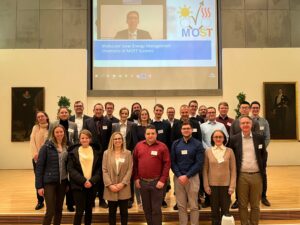Solar energy stored in molecular switches
German Research Foundation (DFG) funds new Research Unit FOR 5499
The availability of solar energy varies greatly in time and space. For the efficient use of solar energy it is, therefore, crucial to develop new storage methods. Using novel molecular materials, so-called organic photoswitches, solar energy can be stored very easily and released as heat when needed. In contrast to most alternative storage concepts, energy absorption, storage and release are all carried out with one and the same molecule.
Solar energy storage with photoswitches poses significant challenges to chemistry, as high energy densities, excellent stabilities, and good control over energy release must be achieved.
Therefore, the further development of this concept requires a multidisciplinary approach, ranging from synthesis via characterization and modeling all the way to testing in demonstration devices.

Through the newly established Research Unit “Molecular Management of Solar Energy – Chemistry of MOST Systems” (FOR 5499), the German Research Foundation (DFG) will be funding the development of this promising concept with a total of around 4.8 million euros for initially four years.
Working groups at sixlocations are involved in the project. In addition to the groups led by Prof. Jörg Libuda (vice spokesperson) and Prof. Andreas Hirsch at the Friedrich-Alexander-Universität Erlangen-Nürnberg, working groups at the universities of Giessen (Prof. Hermann Wegner, spokesperson), Tübingen, Frankfurt, and Heidelberg as well as at the Institute of Materials Science in Barcelona (Spain) will also be involved.
Contact
Prof. Dr. Jörg Libuda
Department of Chemistry and Pharmacy
Chair of Interface Research and Catalysis (Prof. Dr. Libuda)
- Phone number: +49 9131 85-67661
- Email: joerg.libuda@fau.de

